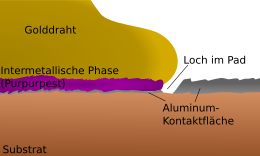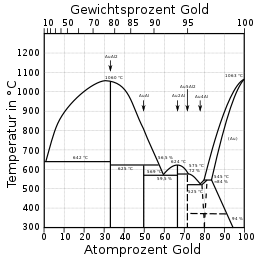Purple plague
In assembly and connection technology, the term purple plague describes a frequent failure mechanism of wire-bonded gold - aluminum contacts due to the growth of intermetallic gold-aluminum connections . Over the lifetime, these phases grow through diffusion processes in the metal ( Kirkendall effect ) and vacancies / cavities / holes ( Kirkendall voids ) are created.
description
When bonding connections made of gold to aluminum contact surfaces, different intermetallic gold-aluminum compounds can form at elevated temperatures (> 340 ° C), such as Au 4 Al, Au 5 Al 2 (“White Pest”) and AuAl and that purple colored AuAl 2 . The formation of thin layers at the connection point is a normal part of gold-aluminum bonding. These phases become larger in subsequent processes such as housing (typically at 175 ° C. for 3 to 5 hours); Thin layers (a few monolayers ) of such compounds also arise when clean surfaces of the two metals are brought into contact, for example when they are vapor-deposited. Aluminum migrates ( diffuses ) from the contact surface in the direction of the gold wire until it is used up. Since the intermetallic compound has a higher specific electrical resistance , the contact resistance increases with the phase growth . Furthermore, the intermetallic compound AuAl 2 is rather brittle , so that the contacts can break more easily under mechanical stress. The “purple plague” therefore leads to a considerable deterioration in the reliability of semiconductor components and integrated circuits .
Naming
The term “plague” was coined as early as the 1960s when massive problems arose in the production of gold-aluminum contacts due to the formation of intermetallic connections. At that time there were no detailed metallurgical investigations into this problem and the characteristic color ( purple ) of the contacts gave it its name. The color goes back to the color of the aluminum-rich, intermetallic compound AuAl 2 .
With today's components, this error occurs only rarely. However, the problem is still significant, especially with high frequency and high power components.
literature
- Ulrich Hilleringmann: Silicon semiconductor technology: Basics of microelectronic integration technology. 5th edition. Vieweg + Teubner Verlag, 2008, ISBN 9783835102453 , p. 162 ( limited preview in the Google book search).
- Rudolf F. Graf: Modern dictionary of electronics . Newnes, 1999, ISBN 0-7506-9866-7 , pp. 602 .
- George Harman: Wire Bonding in Microelectronics . McGraw Hill Professional, 2009, ISBN 978-0-07-147623-2 , pp. 131 ff .
- Shankara K. Prasad: Advanced wirebond interconnection technology . Springer, 2004, ISBN 1-4020-7762-9 , pp. 560 ff .
Individual evidence
- ^ Ulrich people: Physics and its applications in technology and the environment . Hanser Verlag, 2004, ISBN 3-446-22884-5 , p. 168 .
- ↑ George Harman: Wire Bonding in Microelectronics . McGraw Hill Professional, 2009, ISBN 978-0-07-147623-2 , pp. 132 .

